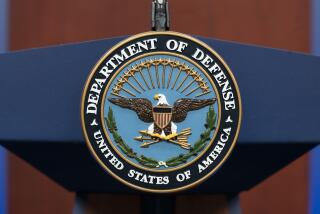No winter respite for U.S. troops in east Afghanistan
- Share via
WASHINGTON — U.S. troops in Afghanistan will continue pursuing extremists in the eastern part of the country over the brutal winter months, but lack the forces in southern areas to mount the same offensive, the top U.S. commander there said Tuesday.
U.S. efforts in eastern Afghanistan could be helped by pressure on extremist groups from Pakistan, said Gen. David D. McKiernan, the U.S. and NATO commander. But U.S. and allied commanders in the south must await the arrival of extra troops sought by McKiernan. Southern Afghanistan includes Helmand province and the city of Kandahar, traditional areas of greater Taliban strength.
In an address to the Atlantic Council of the United States think tank in Washington, McKiernan said that his standing request for about 20,000 additional troops would be approved -- “hopefully quickly” -- by U.S. officials. McKiernan is seeking combat brigades, aviation support and logistics specialists. One brigade already approved is scheduled to arrive by February.
McKiernan acknowledged that Afghanistan has been a secondary effort for the military, after Iraq. But he said that could change next year. “We have perhaps a window of opportunity to apply more resources,” McKiernan said.
In eastern areas, Pakistan’s efforts to prevent extremists from escaping into that country could help a U.S. offensive, McKiernan said.
“We are going to try to . . . eliminate insurgent groups on the Afghan side throughout the winter,” McKiernan said. “We are not going to lower our tempo of operations.” In past years of the war, fighting has slowed during the cold weather.
However, the pressure from Pakistan also could result in a rise in violence as extremists become squeezed between U.S. and Pakistani forces, said Col. John Spiszer, the commander of the 3rd Brigade of the 1st Infantry Division.
Spiszer said more forces would enable him to do more along the border. “I think we are making great progress, but there are just too few of us,” he said, speaking to reporters separately via teleconference from Afghanistan.
There now are more than 30,000 U.S. troops in Afghanistan, along with a roughly equal number from other North Atlantic Treaty Organization member nations.
McKiernan emphasized that political accommodation and reconciliation among Afghan tribes and forces would be a key to eventual stability. But additional troops will speed progress, he said.
He cautioned against transferring strategies from Iraq to Afghanistan, which is a different conflict, he said.
Nonetheless, commanders in Afghanistan are examining the local reconciliation efforts in Iraq that helped craft peace deals with ethnic groups, such as the Sunni Arabs’ so-called Awakening Councils. Their application in Afghanistan would be different, he said.
Instead of tribal-based efforts, McKiernan said he prefers district-based programs to connect tribes and clerics.
--
More to Read
Sign up for Essential California
The most important California stories and recommendations in your inbox every morning.
You may occasionally receive promotional content from the Los Angeles Times.










